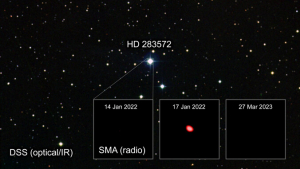
The discovery of a powerful eruption on a Sun-like star more than 400 light years away has been unveiled in research co-authored by a University of Hawaiʻi astronomer. Using the Submillimeter Array (SMA) telescope on Maunakea, a team of astronomers including UH Institute for Astronomy (IfA) astronomer Jonathan Williams observed the star, known as HD283572, intensely brighten by a factor of over 100 during a 9-hour eruption. This finding provides crucial insights into how young stars behave in their early stages and their potential influence on the formation of new planets orbiting them.
“Sometimes discoveries are made by chance, as in this case, but it helps to show us how much we still have to learn. We are now beginning to appreciate the importance of such strong flares from young stars on the planets that form around them,” said Williams.
The results were recently published in the Astrophysical Journal Letters.
Unexpected discovery

Led by astronomer Joshua Bennett Lovell, a SMA Fellow at the Harvard–Smithsonian Center for Astrophysics, the team was on a quest to identify at millimeter wavelengths the residual dusty material generated during the formation of young planets, which are invisible to the human eye. With a mass 40% greater than the Sun, HD283572 is relatively young, at just under 3 million years old. That is more than a thousand times younger than the Sun, an age when Earth-like planets typically start forming around stars. The research team hoped to catch planet formation in action, which is usually marked by a consistent glow at specific wavelengths. However, this time, they encountered something entirely unexpected.

“We were surprised to see an extraordinarily bright flare from an ordinary young star,” said Lovell. “Flares at these wavelengths are rare, and we had not anticipated seeing anything but the faint glow of planet-forming dust.”
The team measured the energy emitted during HD283572’s flare, discovering that it unleashed approximately a million times more energy throughout a 9-hour span than any millimeter flares observed from the Sun’s closest stellar neighbors. According to the astronomers, it ranks amongst the most powerful flares of this kind ever documented.
Ongoing research
The star’s youth and its similarities to the Sun offer key insights into the environments where emerging planets take shape. The presence of flares during this phase carries implications for the eventual evolution of these planets. Ongoing research aims to uncover the frequency of flaring events in HD283572 and explore whether such flares impede the growth of planets and their atmospheres around this type of young star.

